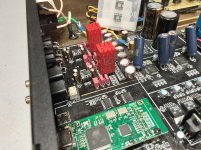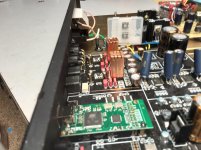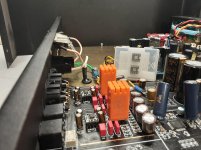First off, I would like to thank Carlos for the opportunity to try out a pair of the Burson Audio V6 Vivid op-amps. Also, my apologies for taking so long to write this. Nothing in 2020 seems to be going as planned.
I’m using these in a AK4497 based DAC. The board has sockets installed so swapping the op-amps is easy. After nearly 40 years in electronics, I have lots of parts sitting around to play with. Some of the op-amps that I have tried with this DAC have been the 5532, OPA2604, LM4562, OPA1612, MUSES8820 and the MUSES02. They all work fine in this DAC and I could live with any of them. However, of all of them my favorite is the MUSES02 for this application. So, I only compared the V6 to the 02.
When I first heard the V6, I was reminded of the smiley face EQ. Back when graphic EQ’s were popular you would see EQ’s with the bass and treble faders boosted and the mids flat or cut. The V6 seemed to have a U or V shaped EQ to it. The first things to stand out was a strong well defined bass, an extended and detailed upper end with a wide deep and layered sound stage. The mid’s however were missing or covered over by the high end. The extended upper range made things like horns, strings and cymbals a little grating and fatiguing over time. This was not an issue with any of the other op-amps I tried. Around the 80 hour mark, I thought I would try shielding the V6’s just to see if that would help the upper range. That is the second picture with them in a grounded copper foil. I checked the PS and outputs again with the scope. Shielding did not seem to improve anything.
Over the next one hundred hours or so, I switched back to the 02 a few times. Each time listening to the V6 was like being at a clear bright sunny beach. Switching to the 02 was like being at that same beach but with a good pair of sun glasses. With the glare and brightness gone, all the subtle details reappeared. The little breaths of a horn player or fingers moving on strings were back. Listening with the 02 was more relaxed and musical. The V6 was more on the analytical and cool side. Also, while the V6 has a large deep sound stage with a musicians in the room sound. The 02 has a huge 3D holographic sound stage that puts the listener in the room with the musicians. The V6 and 02 seem to be complete opposites in their sound. Kind of Yin and Yang.
I normally do not expect a change in op-amp sound after a few hours of warm up. However, around the 140 hour mark, something changed with the V6’s. The upper range mellowed considerably and the mid-range showed up. The FR seemed a lot flatter. With about 250 hours on them now, they are easier on the ears. The up right bass sounds fantastic, the mid’s are present with a slight warmth and horns, etc. on the upper end don’t have me reaching for the skip button. Also, the subtle details in the mid’s are there now. There is still a bit of glare and edge to the upper range. This can be an issue with some recordings or long listening sessions.
In the end I would say the V6 Vivid is a great op-amp in the right system. I have an older headphone amp that leans a little too dark. I plan on trying the V6 Vivid in that unit when time permits. I have a feeling that the V6 Vivid’s detailed and analytical nature will work well in the studio for checking final mixes, etc.
Thanks again Carlos.
I’m using these in a AK4497 based DAC. The board has sockets installed so swapping the op-amps is easy. After nearly 40 years in electronics, I have lots of parts sitting around to play with. Some of the op-amps that I have tried with this DAC have been the 5532, OPA2604, LM4562, OPA1612, MUSES8820 and the MUSES02. They all work fine in this DAC and I could live with any of them. However, of all of them my favorite is the MUSES02 for this application. So, I only compared the V6 to the 02.
When I first heard the V6, I was reminded of the smiley face EQ. Back when graphic EQ’s were popular you would see EQ’s with the bass and treble faders boosted and the mids flat or cut. The V6 seemed to have a U or V shaped EQ to it. The first things to stand out was a strong well defined bass, an extended and detailed upper end with a wide deep and layered sound stage. The mid’s however were missing or covered over by the high end. The extended upper range made things like horns, strings and cymbals a little grating and fatiguing over time. This was not an issue with any of the other op-amps I tried. Around the 80 hour mark, I thought I would try shielding the V6’s just to see if that would help the upper range. That is the second picture with them in a grounded copper foil. I checked the PS and outputs again with the scope. Shielding did not seem to improve anything.
Over the next one hundred hours or so, I switched back to the 02 a few times. Each time listening to the V6 was like being at a clear bright sunny beach. Switching to the 02 was like being at that same beach but with a good pair of sun glasses. With the glare and brightness gone, all the subtle details reappeared. The little breaths of a horn player or fingers moving on strings were back. Listening with the 02 was more relaxed and musical. The V6 was more on the analytical and cool side. Also, while the V6 has a large deep sound stage with a musicians in the room sound. The 02 has a huge 3D holographic sound stage that puts the listener in the room with the musicians. The V6 and 02 seem to be complete opposites in their sound. Kind of Yin and Yang.
I normally do not expect a change in op-amp sound after a few hours of warm up. However, around the 140 hour mark, something changed with the V6’s. The upper range mellowed considerably and the mid-range showed up. The FR seemed a lot flatter. With about 250 hours on them now, they are easier on the ears. The up right bass sounds fantastic, the mid’s are present with a slight warmth and horns, etc. on the upper end don’t have me reaching for the skip button. Also, the subtle details in the mid’s are there now. There is still a bit of glare and edge to the upper range. This can be an issue with some recordings or long listening sessions.
In the end I would say the V6 Vivid is a great op-amp in the right system. I have an older headphone amp that leans a little too dark. I plan on trying the V6 Vivid in that unit when time permits. I have a feeling that the V6 Vivid’s detailed and analytical nature will work well in the studio for checking final mixes, etc.
Thanks again Carlos.
Attachments
A very interesting review. Thank you.
I seldom have the patience to put more than 50hrs on equipment I dislike.
I seldom have the patience to put more than 50hrs on equipment I dislike.
The V6 round 2
OK, round two with the Burson Audio V6 Op-amps. Previously I had demoed the V6 Vivid in my system. I found the V6 Vivid was a little too Vivid in my upstairs system. I think the Vivid will fit in better in my downstairs rig. There I use more PRO and semi-PRO gear.
So, Carlos asked if I had interest in giving the V6 Classic a go. Thinking the Classic may fit into the upstairs rig better I agreed to try it. My upstairs system is were I go when I want to sit back and just enjoy the music and not think about the gear or how it sounds.
I have been trying these different Op-amps in a DAC that I put together a while back. It has 8 pin sockets making things easy to swap. So far, my favorite Op-amp in this DAC has been the Muses02. Tonally it’s very natural and musical with huge holographic sound stage.
To keep this short, I will say the V6 Classic is the first Op-amp I have tried that meets and or beats the Muse02. I liked the sound of the Classic right away. The only issue I thought it had was it sounded a little veiled or murky at first. That cleared up though after a few hours use. Now it’s clear and transparent.
The Classic is nicely extended top to bottom. The bass seems to have a little more weight to it. I notice more thump to chest with it. And that extra weight does not stop at the low notes. Even things like piano notes, plucked strings and cymbal hits seem to have more weight also.
Tonally, I would say if the Muses chip is Zero on the neutral dial, the Classic is about a quarter or half turn up from neutral. This seems to add nicely to detail and transparency the Classic has, without adding any edge or brightness to the upper range.
Soundstage wise, I love the huge wrap around you holographic sound the Muses can make. With the Classic, I get a similar but some what different soundstage. It too can produce a huge soundstage. However difference is, the Classic is a little less forward and does not seem to wrap around you quite as much. However, the Classic is much deeper and a lot more layered then the Muses.
So, to sum this up, I can happily listen either Op-amp all day long. They both have their strengths. Only the Classic however seems to have no weaknesses. At this point the V6 Classic is the new Op-amp king in this system and will stay in place. In fact, the V6 Classic is my new dessert island Op-amp. If I only had one Op-amp, I could happily live with the Classic. It makes my ears happy.
Thanks again to Carlos and Burson Audio for the opportunity to give these fine Op-amps a try. They have changed my mind about discreet Op-amps.
OK, round two with the Burson Audio V6 Op-amps. Previously I had demoed the V6 Vivid in my system. I found the V6 Vivid was a little too Vivid in my upstairs system. I think the Vivid will fit in better in my downstairs rig. There I use more PRO and semi-PRO gear.
So, Carlos asked if I had interest in giving the V6 Classic a go. Thinking the Classic may fit into the upstairs rig better I agreed to try it. My upstairs system is were I go when I want to sit back and just enjoy the music and not think about the gear or how it sounds.
I have been trying these different Op-amps in a DAC that I put together a while back. It has 8 pin sockets making things easy to swap. So far, my favorite Op-amp in this DAC has been the Muses02. Tonally it’s very natural and musical with huge holographic sound stage.
To keep this short, I will say the V6 Classic is the first Op-amp I have tried that meets and or beats the Muse02. I liked the sound of the Classic right away. The only issue I thought it had was it sounded a little veiled or murky at first. That cleared up though after a few hours use. Now it’s clear and transparent.
The Classic is nicely extended top to bottom. The bass seems to have a little more weight to it. I notice more thump to chest with it. And that extra weight does not stop at the low notes. Even things like piano notes, plucked strings and cymbal hits seem to have more weight also.
Tonally, I would say if the Muses chip is Zero on the neutral dial, the Classic is about a quarter or half turn up from neutral. This seems to add nicely to detail and transparency the Classic has, without adding any edge or brightness to the upper range.
Soundstage wise, I love the huge wrap around you holographic sound the Muses can make. With the Classic, I get a similar but some what different soundstage. It too can produce a huge soundstage. However difference is, the Classic is a little less forward and does not seem to wrap around you quite as much. However, the Classic is much deeper and a lot more layered then the Muses.
So, to sum this up, I can happily listen either Op-amp all day long. They both have their strengths. Only the Classic however seems to have no weaknesses. At this point the V6 Classic is the new Op-amp king in this system and will stay in place. In fact, the V6 Classic is my new dessert island Op-amp. If I only had one Op-amp, I could happily live with the Classic. It makes my ears happy.
Thanks again to Carlos and Burson Audio for the opportunity to give these fine Op-amps a try. They have changed my mind about discreet Op-amps.
Attachments
Hi Guys,
We have available a few samples for the next month. If you have a good project (Diy or opamp rolling) please pm me. I will be glad to send you our opamps.
Supreme Sound Opamp V5i – Burson Audio
Supreme Sound Opamp V6 – Burson Audio
Best,
We have available a few samples for the next month. If you have a good project (Diy or opamp rolling) please pm me. I will be glad to send you our opamps.
Supreme Sound Opamp V5i – Burson Audio
Supreme Sound Opamp V6 – Burson Audio
Best,
Thanks again to Carlos and Burson Audio for the opportunity to give these fine Op-amps a try. They have changed my mind about discreet Op-amps.
Ha! there's nothing discreet about something bright red or orange that tall plugged into a PCB!
Perhaps you meant discrete?
I'm struggling to find a proper datasheet for these devices, only some short-form one that doesn't mention input voltage or current noise, but does admit to 0.02% distortion which isn't exactly state of the art, and a max operating temperature of 52C which is worrying low given the kind of temperatures seen in amp enclosures sometimes!
Whoa! what's this? the 170µA bias current (is that a misprint?) is worrying - though the input resistance is quoted as 50Mohm... Perhaps that's 170nA bias current and 0.1nA current offset, not 170µA and 0.1mA ???
Is there some reliable source of data for these devices? Including the opamp basics like voltage noise and current noise plots, Bode plot, input and output voltage ranges, lack of gross misprints, etc etc?


